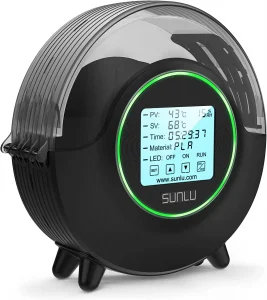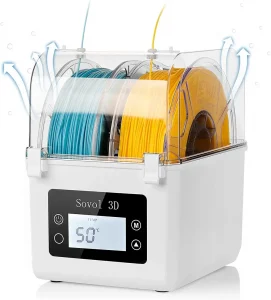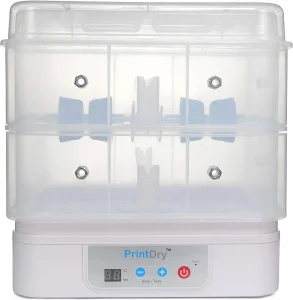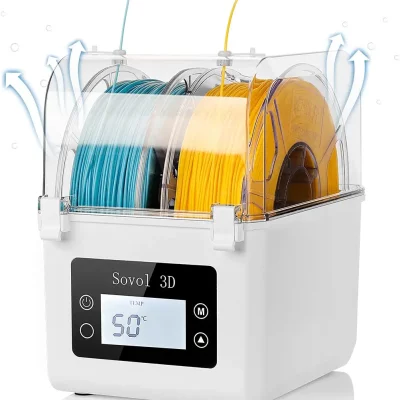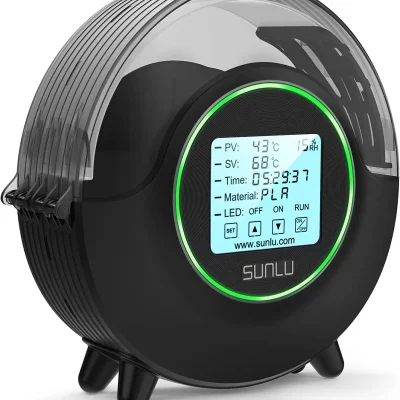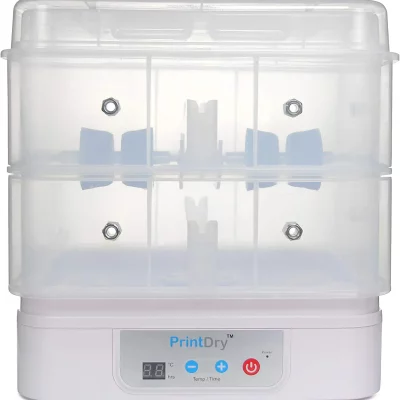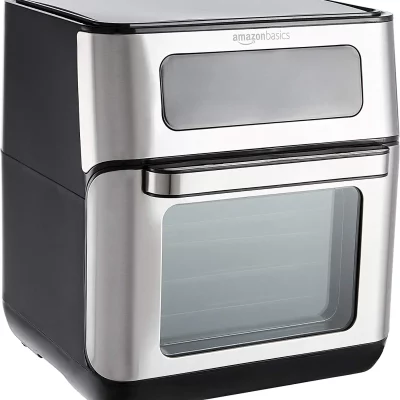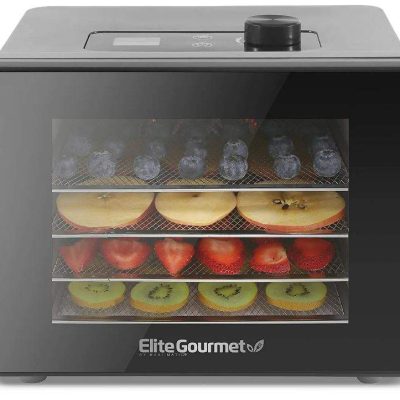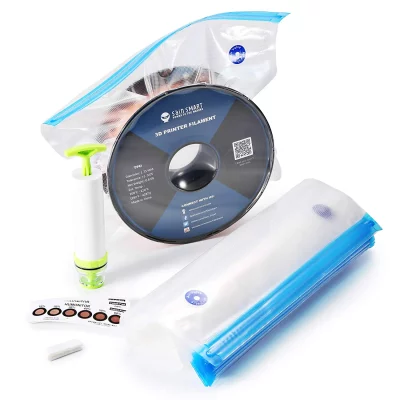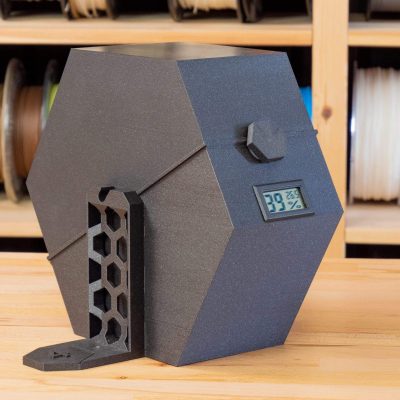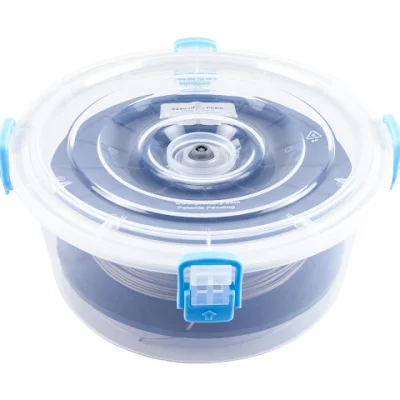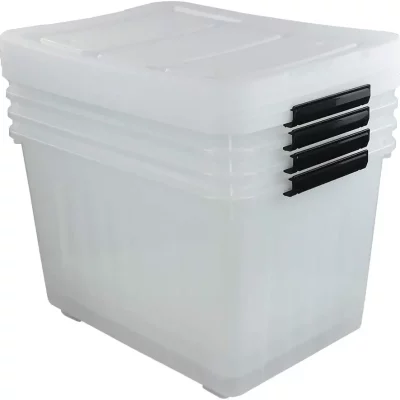- Last Updated: January 12, 2024
-
 Jackson O'Connell
Jackson O'Connell
 Are you getting low-quality 3D prints? It might not be your printer, but actually your filament!
Are you getting low-quality 3D prints? It might not be your printer, but actually your filament!
Yep, that’s right! If your filament is in a humid environment, the plastic will absorb moisture, degrading its quality. This leads to low-quality prints with poor details and weak layers.
Luckily, wet filament isn’t a permanent issue. You can use a filament dryer to remove the moisture from the plastic to restore the printing performance of the filament. Additionally, you can prevent filaments from getting wet in the future by storing them in a filament dry box!
Interested in getting a filament dryer or dry box for your 3D printer? We’ve reviewed the best of both in the sections below!
Best Filament Dryers & Dry Boxes At A Glance
Best Filament Dryers:
1. Sovol SH01 (Best Choice)
2. Sunlu FilaDryer S2 (Best Value)
3. PrintDry Filament Dryer Pro (Premium Choice)
4. Oven
5. Food Dehydrator
Best Dry Boxes:
6. Vacuum Storage Bag
7. Printable Drybox: PrusaPrinter DryBox V2
8. PrintDry Filament Storage Container
9. DIY Plastic Storage Box
Best Filament Dryers
In this section, I’ve reviewed some of the best filament dryers on the market, including some budget options and some higher-end products to give you some variety. Enjoy!
Sovol is a 3D printing company that makes a variety of products, from printers to filaments and even a filament dryer, known as the SH01. The Sovol SH01 is my personal favorite filament dryer box because it can function as both a filament dryer and a dry box. This is possible due to the built-in heater and the silicone seal that prevents water from getting in.
The heater runs on a 12-hour heating cycle, which is more than enough time to remove all the moisture from the filament. And you can control the temperature inside the box using the buttons and LED interface, with options of 40, 45, and 50 °C.
Additionally, inside the box is a space where you can place up to four desiccant bags, which remove oxygen from filament. This is a great feature for any long-term filament storage solution as desiccants won’t ruin the diameter of the filament but still help ensure no moisture is present.
It’s also worth mentioning that the Sovol SH01 can store two filament spools. There are even 1.75-mm holes at the top to allow you to use the filament with the spools inside.
To be perfectly honest, I tried finding something wrong with the Sovol SH01, but I can’t come up with anything. I’ve never had a problem with it, so if you’re okay with spending a little more than a typical filament dryer, I think you’ll love the SH01.
Pros
- Can heat two spools at once
- Preset heating cycles
- Easy-to-use LED control interface
- Filament holes (you can use the spools inside)
- Space for desiccant (silica gel) packets
Cons
- Heating capabilities aren’t amazing (only 50 °C range)
Sunlu is another manufacturer of 3D printing products, and the FilaDryer S2 is their latest filament drying machine, replacing the S1. The first thing you’ll notice about the FilaDryer S2 is its unique shape: a circular container that fits a single filament spool perfectly!
While it doesn’t store more than one regular-size filament spool (2-kg spools won’t work), you do get to choose between white or black for the color of the machine. This is perfect if you like to have a color-coordinated workspace like me!
But on a more technical note, the FilaDryer S2 is an exceptional filament dryer, capable of heating filament as low as 35 °C and as high as 70 °C. This is enough of a temperature range to dry basically any filament material, from PLA to PC! Even better is that Sunlu has implemented 360° heating, so the filament is dried from all-around.
What I was most surprised about, though, was the amazing user interface placed on the side of the cylindrical container. On top of letting you control the temperature, set material, and heating time, the S2 also shows you the internal humidity.
The FilaDryer S2 is noticeably more expensive than other filament dryers, even more so than the SH01. But if you want a futuristic-looking, cutting-edge filament dryer, then the FilaDryer S2 is your best bet.
Pros
- Humidity sensor and LED screen
- Easy-to-use control interface
- Can heat up to 70 °C
- 360° heating for even drying process
- Visually appealing design
- Easy access hinge door
- Filament holes (you can use the spool inside)
Cons
- Can only dry one spool at a time
- The UI is a little crowded
PrintDry is a company that specializes in making filament drying and storage solutions. The PrintDry Filament Dryer Pro is perhaps the highest-quality filament drying machine money can buy you.
While it’s a good bit more expensive than other filament dryers, it’s 100% worth it. I have buyer’s regret every time I buy a stick of gum at a gas station, but I never lose a second of sleep over this purchase. Let me tell you why!
First off, the Filament Dryer Pro fits two regular-sized spools, but the manufacturer also included an extra part that modifies the Dryer Pro to fit “Jumbo” (Texas-sized) spools. This extra space is a godsend if you’re like me and have a few printers and more than a few filament spools.
Second, the container section of the Filament Dryer Pro has a double wall. This makes it 100% certain that no moisture will ever reach your filament spools.
But the drying abilities of the Filament Dryer Pro have got to be my fav part about this product. The heater onboard the machine can maintain temperatures between 35 and 75 °C, which is the perfect range for drying all 3D printing filaments, whether it’s PLA and ABS or nylon and PC.
The control interface on the machine doesn’t look like much, but the simplicity is something I admire. The 2-digit LED interface reads out the internal temperature and the time remaining for the heating cycle. On this note, you can control the temperature and set timers for the heater using the plus and minus buttons right next to the LED display.
If you’re willing to make the initial investment, I promise you that you’ll love the results that the PrintDry Filament Dryer Pro brings. It’s the perfect solution for anyone who has a wide variety of filaments and wants them as dry as possible.
Pros
- Amazing heating capabilities (35-75 °C)
- Filament holes (you can use the spools inside)
- Simplistic and easy-to-use UI (with temperature and timer control)
- Optional fittings for different filament spool sizes
- Double wall structure for maximum moisture prevention
- Optional upgrades for an additional drying chamber
Cons
- The lid design is kind of too simplistic (not hinged)
Next up, we’ve got the oven, easily the most convenient way to dry your filament because there’s probably one just a few yards away from your printer. And you won’t have to spend any extra money!
And, if you’re wondering how an oven made it on this list, think about this: a traditional oven has everything a good filament dryer has. That’s right! It’s got a powerful heater (almost too powerful), a large heating area, easy-to-use controls, and an almost-air-tight seal.
Hilariously, if you’re using an oven, the question becomes “can it go as low as 50 °C?” rather than “as high”. On this note, many ovens actually can’t go as low as 50 °C, with minimum temperatures usually being around 70 °C.
While 70 °C is above the recommended temperature for drying PLA (50 °C), as long as you only keep the spool in for just 2-3 hours (rather than 4-6), you should be fine. And, for higher-temperature materials, like PC or ABS, you can leave spools in for 4-6 hours as opposed to 10-12 if you were using 50 °C.
There’s not much else to explain about the oven solution for filament drying as everyone’s oven varies. But don’t sleep on this method as it’s 100% free for most people and super convenient. Plus, you probably won’t even notice the difference between filament dried in a real filament dryer device versus an oven.
Pros
- Super convenient
- Free for most people
- High-temperature capabilities
- Fast drying process
Cons
- No filament holes (can’t print with spools inside)
- Not exactly sanitary
You may have a food dehydrator in your kitchen, but did you know that they also make for terrific filament dryers? Just like these devices pull out the moisture from fruits, meats, and vegetables, they can dry wet filaments so you can get back to printing.
Like an oven, food dehydrators vary in shape, size, and build quality, but most food dehydrators feature a small control panel and enough space to fit at least one spool of filament. And they’re not too pricey, with most costing under $50 on Amazon! But you might already have one stowed away in your kitchen cabinet!
But how well can they dry? Food dehydrators pull moisture by circulating hot air for extended periods of time. As such, drying filament with a food dehydrator isn’t the fastest process, but it is very effective if you give it 4-8 hours.
So, if you’ve already got a food dehydrator, definitely try it out to dry your filament before purchasing a different device!
Pros
- Inexpensive (free if you already have one)
- Multi-purpose and convenient
- Amazing at removing moisture from the air
- Basically no risk of overheating filament
Cons
- Most dehydrators aren’t large enough for 1 or more spools
- No filament holes (can’t print with spools inside)
Best Dry Boxes
Now it’s time to talk about the best dry boxes! These are typically less expensive than filament dryers due to their lack of a heater, but they’re still super important to your setup!
A vacuum storage bag is surprisingly one of the most effective ways to store 3D printer filament in a dry manner long-term. These bags look like regular air-tight plastic bags, but with a twist: they have a small hole on one side. You can attach an air pump to this hole (usually by screwing it on) and then manually remove all of the oxygen, and thus, all of the moisture, from the bag.
Vacuum storage bags are often used for long-term storage of meats and other food. However, you can also find versions of these bags specifically meant for 3D printing, such as eSun’s vacuum bag or the SainSmart eVacuum.
These 3D printing-purpose bags are the easier option for most because they come with a few bags, and each one is properly sized to fit one filament spool. But if you find a much larger bag that fits a few spools at once, there shouldn’t be a big downside, so go for it!
Due to the simplistic nature of vacuum storage bags, there isn’t really a whole lot more than can be said, as their features are nonexistent. However, it is worth noting that you won’t be able to use the filament inside the bag. That’s because the filament spool can’t easily rotate inside the bag, and any exit hole on the bag would break the vacuum seal and not be good for keeping the filament dry.
Pros
- Many options
- Very inexpensive
- No air allowed, so no moisture inside
- Air pump included (for most products)
Cons
- No filament hole (can’t print with spools inside)
- Not very visually appealing
What if I told you that you could make an excellent filament dry box without purchasing almost any additional hardware? Well, this is me telling you! The PrusaPrinter DryBox V2 is an almost fully 3D-printed filament dry box that boasts many features.
On top of being low-cost because it’s primarily 3D printed, the DryBox V2 offers exceptional water prevention. This is due to silica gel pods that you’re supposed to insert into the enclosed space of the container. These gel pods cost very little (in bulk) and help remove oxygen and water from your filament’s space to keep it dry.
The container is also extremely well-designed, with a functional hinge in the middle that allows you to quickly access and swap the filament spool if you need to. And, as an optional installment, you can add a humidity sensor with a small LED display so that you always know the dryness of your spool.
But my favorite part about the DryBox V2 is the bearings and cylindrical rods that mount to the bottom of the container. These components aid the filament spool in rotating during the printing process so that there isn’t significant resistance against the extruder motor. On this note, there’s a spot to add a PTFE coupler and Bowden tube on the surface of the container, so you can print with a filament inside.
The PrusaPrinters DryBox V2 is the perfect long-term filament storage solution for anyone looking for a fun 3D printing project. However, if you’re not too DIY-y or want a dry box that can fit multiple spools at once, then I suggest picking a different option from the list. If you are interested, though, check out this build manual, which contains more info about the project.
Pros
- Easy-to-follow instructions
- Customizable
- Optional humidity sensor
- Well-designed frame with hinge for easy access
- Space for silica gel pods
- Inexpensive
- Filament hole for printing with spools inside
- Bearing to allow spools to rotate inside
Cons
- Only holds one spool
- 3D prints need to be dimensionally accurate
- 3D prints are porous and can let moisture inside
- You have to do everything on your own
Next, we’ve got another item from PrintDry. The PrintDry Filament Container is easily my favorite PrintDry solution and the item that brings the most bang for your buck on their site.
The PrintDry Filament Container costs a little under one Benjamin Franklin (that’s $100 for all you not-history-peeps), and it comes with six different plastic boxes (and lids). These plastic boxes are similar to your typical kitchen Tupperware, but are 100% transparent, cylindrical in shape, and sized just large enough to fit a regular filament spool (each).
What’s fun is that the boxes are meant to be stacked, making it easy to be efficient with the space in your 3D printer room. It really brings out the organization freak inside of me.
The four clips and silicone seal on the container create an air-tight seal so that no moisture will ever contaminate your spool. Additionally, the containers come with silica gel packets, meant to go in each container to further help keep filament dry.
Sadly, there isn’t a hole anywhere on the container where you could fit a PTFE tube or coupler, so printing with stored filaments isn’t an option. But if you want a long-term, super-dry filament storage option for up to six spools, then the PrintDry Filament Container set is the perfect option for you and your filaments!
Pros
- A good bang for your buck
- Six different containers
- Containers are stackable (conserves space)
- Airtight seal
- Included silica gel packets for the best drying
Cons
- On the more expensive side
- No filament hole (you can’t use the spool inside)
The last filament dry box solution I want to talk about is just a typical plastic storage container. This type of dry box is a little more convenient and DIY-ish than the other options because you have to find a regular plastic box and fit it to suit your filament spools. However, it’s no less effective than a proprietary dry box product when it comes to keeping filaments dry.
As for deciding which plastic container to use, I suggest looking at any large Tupperware boxes or reusable cereal containers. That’s because these boxes usually have strong rubber seals, which will help prevent moisture from getting to the filament. Additionally, these boxes should be large enough to fit at least one regular-sized spool of filament.
But how do you turn a regular old plastic container into the best filament dry box possible?
While there are many ways you can repurpose a container to store filament, I like to start by measuring the container and 3D printing a spool holder to go inside. Add a bearing to the spool holder too so that the spool’s rotational motion is smooth and frictionless inside the box.
I also suggest drilling a small hole at the top or the side of the plastic box and fitting a PTFE tube coupler with the tubing inserted. This will give your filament a way to get out of the box so you can print with it in the container but won’t give moisture too much room to get in.
Overall, I recommend taking the DIY plastic box route if you’re a fan of making your own stuff. This solution usually costs $20 or less, which is much less than the other options, and it gives you the opportunity to customize the features.
Pros
- Can be modified to fit your needs
- Inexpensive
- Endless possibilities
Cons
- You have to design and make it yourself
- Not beginner friendly
Difference Between Filament Dryer & Dry Box
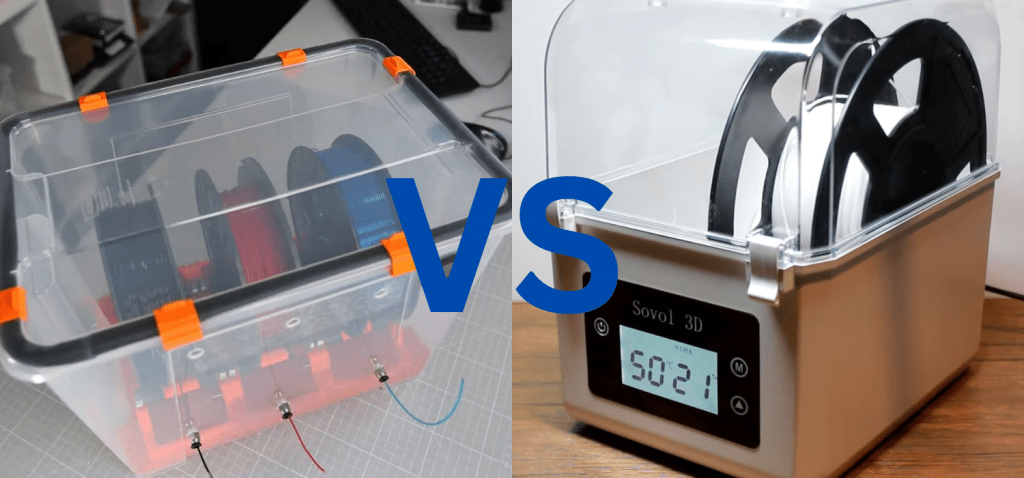
A filament dryer is a machine that actively removes moisture from a filament spool, usually by heating up the filament slightly. Filament dryers are what you use to make wet filament usable, but they’re not always the best place to store the spool during printing. That’s because, while short-term exposure to low heat helps dry filament, long-term exposure might affect the diameter of the filament.
That’s where a filament dry box comes in. Filament dry boxes are the better long-term storage solution for filament because they don’t actively heat the filament but, instead, ensure that no moisture gets in. Many people, including myself, like to store the filament they’re printing inside a dry box!
Of course, there’s some grey area between filament dryers and dry boxes as some devices can double as both. These dual-purpose devices are excellent choices if you’re trying to save money!
Benefits of Using a Filament Dry Box
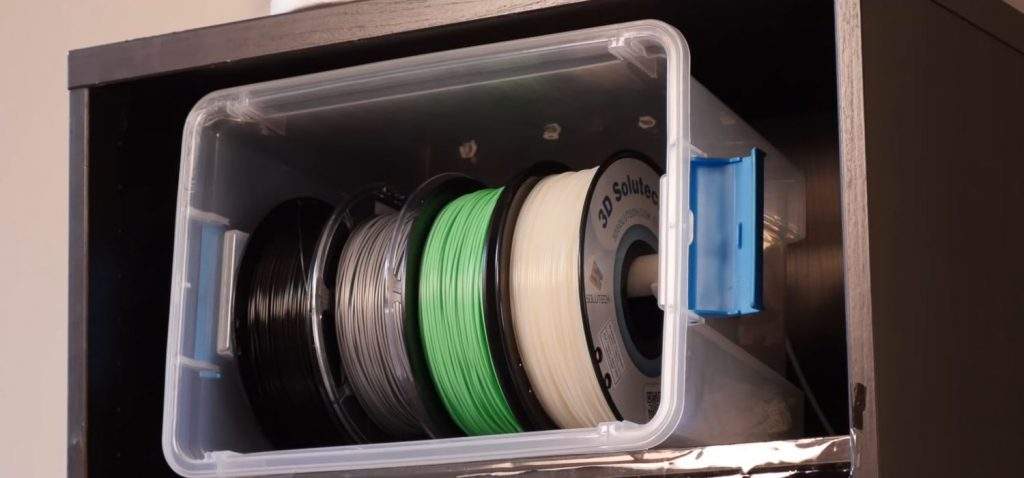
Using a filament dry box alongside your printer is a great way to not have to worry about re-drying your filament every few weeks. As a result, filament dry boxes also significantly help with the quality of prints. You won’t have any fuzz or stringing on your prints like you might with wet filament, and small features and details will come out better.
And if you have good hearing, then you also might like to know that using a filament dry box will ensure you never hear that crackling or bubbling sound that occurs when the wet filament is melted.
But more than just print quality and noise, using a filament dry box also can make your prints (and filament) stronger. That’s because your filament will be less brittle when it’s inside the dry box, so your prints will be too!
Considerations for a Filament Dry Box
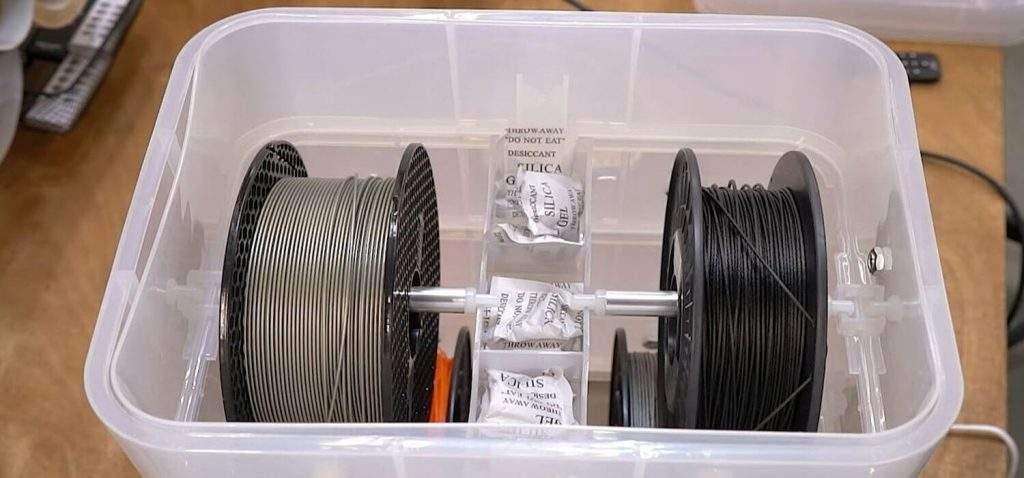
If you’re having trouble deciding which filament dryer or dry box to get, it’s important to review the main factors and features of these machines. We’ve explained the ones you should consider for each product below:
Drying Ability
The first consideration is the drying ability, which mainly applies to filament dryers as filament dry boxes don’t usually have one.
As you might have guessed, the higher a filament dryer can heat up, the better the product. I’d suggest not getting a dryer that can’t at least get to 50 °C, as this is perfect for drying PLA and other materials.
On top of just the maximum temperature, though, you should also look for the type of heating. If there’s just one heating fan, the filament will be a lot less dry than if the filament dryer uses surround 360° heating. So keep this in mind when picking a dryer out!
Control Interface
Second, you should look at the control interface on your filament dryer or dry box, as this will help you operate the machine. Most filament dryers and dry boxes have a small LED interface with a few buttons, which are terrific.
But give extra points to any machine that has a touchscreen interface or a well-built and easy-to-use user interface as these features greatly improve the user experience.
The best place to look when determining how the quality of a device’s control interface is the reviews!
Size
Contrary to some beliefs, size does matter (haha)! That’s right! The more filament spools a dryer or dry box can hold, the more filaments you can keep from getting wet.
Most filament dryers or dry boxes can only store either one regular-sized filament spool, which is suitable for most users. But, if you’ve got a few 3D printers or use a variety of filaments in a month, look for the machines that hold two or more spools.
Price (Value)
Lastly, like with anything, you should consider the price, but more importantly, the value of a filament dryer or dry box. Of course, everyone’s got a budget for their 3D printing gear, but don’t just look at the price of a product alone. Instead, evaluate the features of the filament dryer or dry box alongside its price to see if you’re getting a bargain.
For example, in my opinion, it’s worth paying an extra $5 to get a filament dryer with space for two spools instead of one. But what features matter to you is, at the end of the day, all up to you!
Why Do You Need to Keep the Filament Dry?
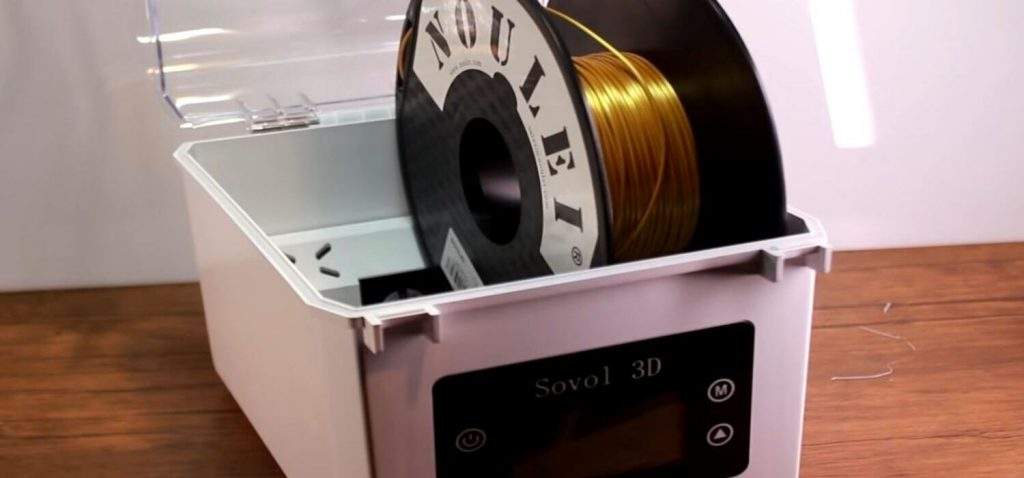
Keeping your filament dry is necessary if you want high-quality prints. If you let moisture infiltrate your filament spool, you can expect the small details on prints to come out terribly as the moisture will negatively affect the extrusion process.
Wet filament is also known to cause an inconsistent filament diameter. That’s because when water gets into the filament, it swells the diameter of the filament in some places, making it different from the expected size (e.g. 1.75 mm). Then, when the filament reaches the hot end, the deviating diameter will cause extrusion issues like stringing, over and under extrusion, and dimensional accuracy on prints.
And, if you understood none of that, then just know that wet filament equals bad prints, so it’s important to keep your filament dry.
How Will You Know if Filament is Wet?
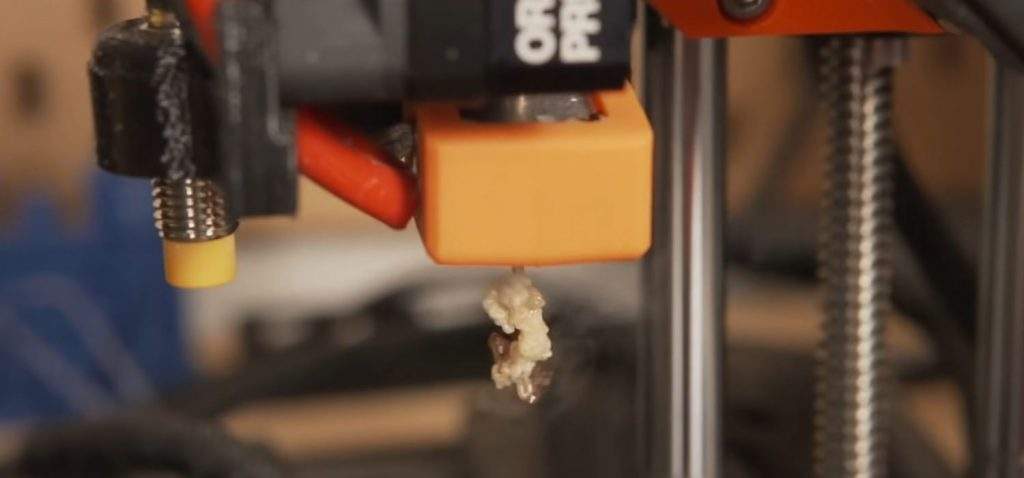
The biggest tell for wet filament is seeing a little steam as filament is pushed out the nozzle. This is caused by the heat of the nozzle evaporating moisture in the filament and is a surefire sign that you need to dry your filament.
But steam usually only happens if your filament is very wet. You may also be able to tell that your filament is wet if you hear a slight crackling noise as filament is extruded.
Additionally, the small details on 3D models tend to come out very poorly when the filament is wet. You may also see higher-than-usual levels of stringing on prints.
If any of these happens, be safe and dry your filament to eliminate the problem!
Conclusion
Wet filament will always equal bad prints. So don’t wait for your 3D prints to start looking terrible before you dry your filament; just start now!
If you already have wet filament, the first thing you’ll need is a filament dryer. The Sovol SH01 and the Sunlu FilaDryer S2 are two of my favorite options. The SH01 is the better option if you have multiple printers due to its two-spool-space, but for the best drying abilities, the FilaDryer S2 is the one.
But if you don’t want to drop any cash on a dryer, take the easy route and just shove your spools into your kitchen oven for a few hours.
And, once your filament is dry, keep it that way! You’ll want to store your filament, whether you’re using it at the moment or not, in a filament dry box. If you want to make your own, I suggest getting a plastic storage box at your local hardware store and modifying it. But if you want a quick-and-easy solution that’s a good bang for your buck, you can’t go wrong with the PrintDry containers.




